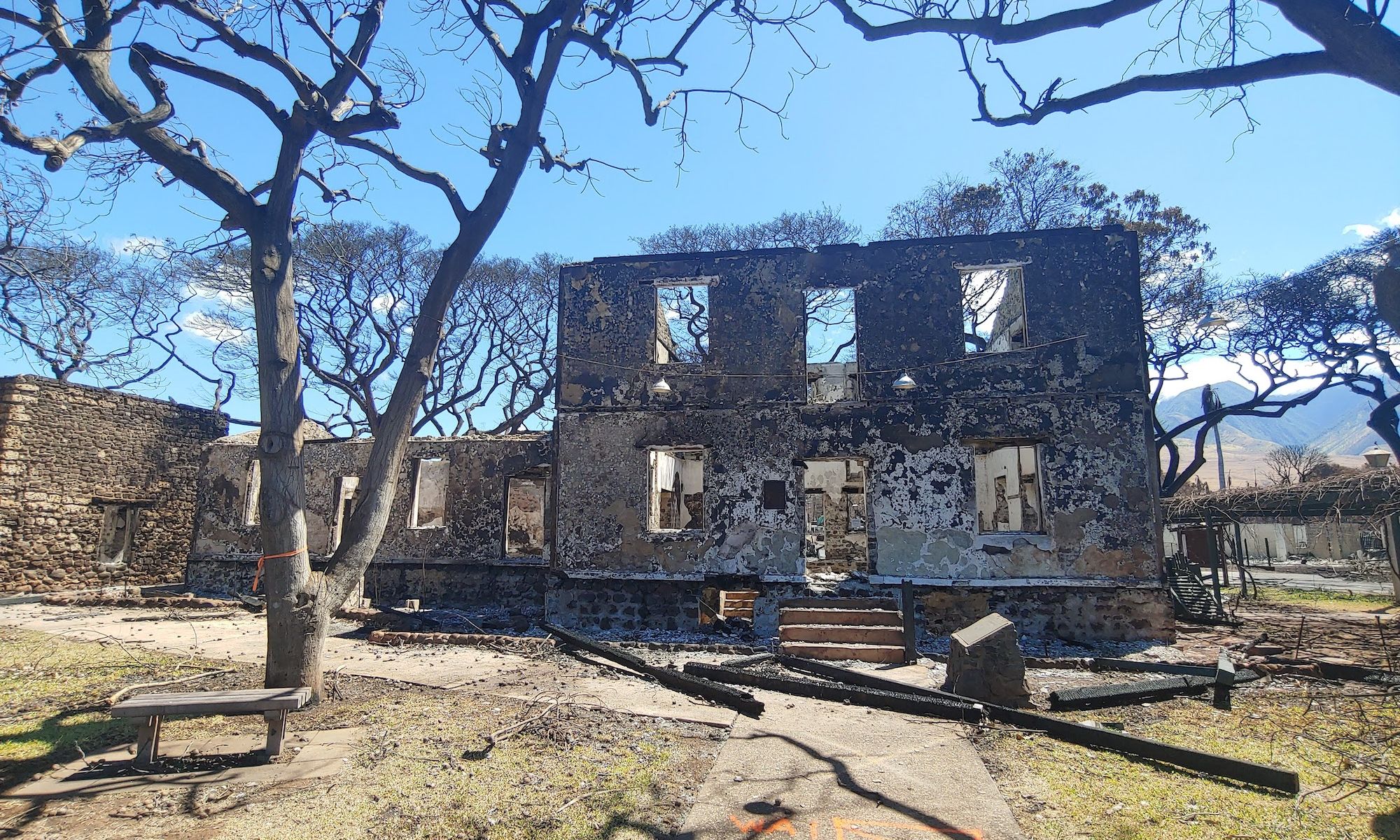The Baldwin Home Museum in Lahaina, one of the historic properties managed by the Lahaina Restoration Foundation, following the 8 August fires Photo by Jesse Neizman, courtesy Lahaina Restoration Foundation
How could it all be gone? A vibrant town. Historic buildings. Beautiful parks. Friendly people. A famous street. Cultural sites and art galleries. Restaurants and shave ice stands. A bustling harbour. Lively neighbourhoods. Gone.
The wind-fed wildfire tore through Historic Lahaina and surrounding neighbourhoods on 8 August, destroying everything within the 3.4 square miles. Nothing could stop it.
Lahaina, the fabled and favourite vacation spot, the first capital of the Hawaiian Kingdom, the art capital of the Pacific, a National Historic Landmark—in ruins. With nearly 100 lives lost, many more people barely escaping and thousands of homes burnt to the ground, community hubs sprouted up offering free food, counselling, first aid, housing, supplies and other essentials. The community came together to tend to its own.
The Baldwin Home Museum in Lahaina, one of the historic properties managed by the Lahaina Restoration Foundation, before the 8 August fires Photo courtesy Lahaina Restoration Foundation
As the caretaker of the Lahaina Historic District and owner or manager of 14 historic structures, the Lahaina Restoration Foundation (LRF) was also spurred into action. Within days of the fire, the foundation’s destroyed office was replaced with a new one on the other side of the island. Staff were reduced and fundraising began in earnest. Except for one, all the historic structures the foundation managed or owned were demolished or gutted by the fire with 90% of contents destroyed. This was a gut punch to an organisation celebrating its 60th anniversary of saving history.
Calls and meetings with insurance agents, the Federal Emergency Management Agency, preservation experts, museum professionals, archaeologists and others were held. Staff began certification training to enter the heavily damaged buildings full of toxic ash to safely retrieve historic artifacts if they could be found.
Even though other disasters seized the headlines, the world did not lose interest in Lahaina and articles about the Maui wildfires remain frequent. We sat for interviews and answered questions, always promoting the Hawaiian culture and importance of Lahaina as the first capital of the Hawaiian Kingdom.
The Masters Reading Room in Lahaina, one of the historic properties managed by the Lahaina Restoration Foundation, before the 8 August fires Photo courtesy Lahaina Restoration Foundation
The Masters Reading Room in Lahaina, one of the historic properties managed by the Lahaina Restoration Foundation, after the 8 August fires Photo by Jesse Neizman, courtesy Lahaina Restoration Foundation
With only a month-long pause during August, we reinstated the popular, free Hawaiian Music Series concert, which has been held monthly for 15 years on the front lawn of the Baldwin Home Museum on Front Street in Lahaina. With many Lahaina “refugees” now located in Wailuku, the September concert was been rescheduled for the Great Lawn at University of Hawai‘i Maui College. Plans are underway to begin student programmes, including the educational Lahaina Quest camps held during school breaks and hands-on Hawaiian cultural classes for adults.
The biggest challenge for the LRF is the loss of a substantial amount of earned income that the staff has carefully nurtured over the 60 years of the foundation’s existence. The earned income from a busy parking lot, commercial rentals and retail sales covered most of our operating costs. In one horrific day, that income became zero and will remain zero until the economic vitality of the town returns.
As we move forward, we will be more creative in the methods we use to educate our community, our youth and our visitors. We will use new technology and platforms to share Lahaina’s stories and preserve our culture. We will visit schools and hotel lobbies with our new digital exhibits and oral histories. We will provide seminars and presentations to civic groups, and we will boldly share the story of Lahaina and the fire that upended life as we know it.
Although we lost many tangible reminders of Lahaina’s storied past, we did not lose our history. We did not lose our love for Lahaina or the love for each other and we will continue our work to share the rich story of Lahaina with the world.

